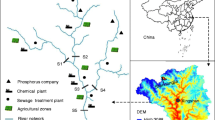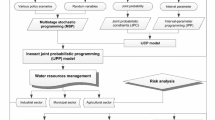Abstract
A recourse-based nonlinear programming (RBNP) method is developed for stream water quality management under uncertainty. It can not only reflect uncertainties expressed as interval values and probability distributions but also address nonlinearity in the objective function. A 0-1 piecewise linearization approach and an interactive algorithm are advanced for solving the RBNP model. The RBNP is applied to a case of planning stream water quality management. The RBNP modeling system can provide an effective linkage between environmental regulations and economic implications expressed as penalties or opportunity losses caused by improper policies. The solutions can be used for generating a variety of alternatives under different combinations of pre-regulated targets, which are also associated with different water-quality-violation risk levels and varied potential economic penalty or loss values.











Similar content being viewed by others
References
Anderson ML, Mierzwa MD, Kavvas ML (2000) Probabilistic seasonal forecasts of droughts with a simplified coupled hydrologic-atmospheric model for water resources planning. Stoch Environ Res Risk Assess 14(4):263–274
Bakar KS, Hossain SS (2010) Inference on environmental population using horvitz-thompson estimator. J Environ Inform 16(1):27–34
Box GEP, Hunter WG, Hunter JS (1978) Statistics for experimenters. Wiley, New York
Chaves P, Kojiri T (2007) Deriving reservoir operational strategies considering water quantity and quality objectives by stochastic fuzzy neural networks. Adv Water Resour 30:1329–1341
Chen MJ, Huang GH (2001) A derivative algorithm for inexact quadratic program-application to environmental decision-making under uncertainty. Eur J Oper Res 128:570–586
Eckenfelder WW Jr (2000) Industrial water pollution control, 3rd edn. The McGraw-Hill Companies, Inc., USA
Edirisinghe NCP, Patterson EI, Saadouli N (2000) Capacity planning model for a multipurpose water reservoir with target-priority operation. Ann Oper Res 100:273–303
Fujiwara O, Puangmaha W, Hanaki K (1988) River basin water quality management in stochastic environment. J Environ Eng 114(4):864–877
Haith AD (1982) Environmental systems optimization. Wiley, New York
Huang GH (1996) IPWM: an interval parameter water quality management model. Eng Optim 26:79–103
Huang GH, Loucks DP (2000) An inexact two-stage stochastic programming model for water resources management under uncertainty. Civ Eng Environ Syst 17:95–118
Huang GH, Xia J (2001) Barriers to sustainable water-quality management. J Environ Manage 61:1–23
Huang WC, Liaw SL, Chang SY (2010) Development of a systematic object-event data model of the database system for industrial wastewater treatment plant management. J Environ Inform 15(1):14–25
Karmakar S, Mujumdar PP (2006) Grey fuzzy optimization model for water quality management of a river system. Adv Water Resour 29:1088–1105
Kentel E, Aral MM (2004) Probabilistic-fuzzy health risk modeling. Stoch Environ Res Risk Assess 18(5):324–338
Kerachian R, Karamouz M (2007) A stochastic conflict resolution model for water quality management in reservoir-river systems. Adv Water Resour 30:866–882
Li YP, Huang GH (2009) Two-stage planning for sustainable water quality management under uncertainty. J Environ Manage 90(8):2402–2413
Li YP, Huang GH, Nie SL (2006) An interval-parameter multi-stage stochastic programming model for water resources management under uncertainty. Adv Water Resour 29:776–789
Li YP, Huang GH, Chen X (2009) Multistage scenario-based inexact-stochastic programming for planning water resources allocation. Stoch Environ Res Risk Assess 23:781–792
Loucks DP, Stedinger JR, Haith DA (1981) Water resource systems planning and analysis. Prentice-Hall, Englewood Cliffs
Lund JR (2002) Floodplain planning with risk-based optimization. J Water Resour Plan Manage ASCE 128(3):202–207
Lung WS, Sobeck J, Robert G (1999) Renewed use of BOD/DO models in water-quality management. J Water Resour Plan Manage ASCE 125:222–230
Lv Y, Huang GH, Li YP, Yang ZF, Liu Y, Cheng GH (2010) Planning regional water resources system using an interval fuzzy bi-level programming method. J Environ Inform 16(2):43–56
Maqsood I, Huang GH, Huang YF (2005) ITOM: an interval-parameter two-stage optimization model for stochastic planning of water resources systems. Stoch Environ Res Risk Assess 19:125–133
Masliev I, Somlyody L (1994) Probabilistic methods for uncertainty analysis and parameter estimation for dissolved oxygen models. Water Sci Technol 30:99–108
Qin XS, Huang GH (2009) An inexact chance-constrained quadratic programming model for stream water quality management. Water Resour Manage 23:661–695
Qin XS, Huang GH, Zeng GM, Chakma A, Huang YF (2007) An interval-parameter fuzzy nonlinear optimization model for stream water quality management under uncertainty. Eur J Oper Res 180:1331–1357
Revelli R, Ridolfi L (2004) Stochastic dynamics of BOD in a stream with random inputs. Adv Water Resour 27:943–952
Sivakumar C, Elango L (2010) Application of solute transport modeling to study tsunami induced aquifer salinity in India. J Environ Inform 15(1):33–41
Viessman JrW, Hammer MJ (1998) Water supply and pollution control, 6th edn. Addison Wesley Longman, Inc., California
Acknowledgments
This research was supported by the Natural Sciences Foundation of China (50979001) and Major Science and Technology Program for Water Pollution Control and Treatment (2009ZX07104-004). The authors are grateful to the editors and the anonymous reviewers for their insightful comments and suggestions.
Author information
Authors and Affiliations
Corresponding author
Appendix: Solution method
Appendix: Solution method
A two-step method is proposed for solving the RBNP model (i.e. model 7a–7l). The submodel corresponding to f + can be formulated in the first step when the system objective is to be maximized; the second submodel (corresponding to f −) can then be formulated based on the solution of the first submodel. Thus, the first submodel can be formulated (assume that B ± > 0 and f ± > 0) as follows:
subject to:
where x + j and x + jk (j = 1, 2, …, j 1) are upper bounds of the first-stage variables with positive coefficients in the objective function; x − j and x − jk (j = j 1 + 1, j 1 + 2, …, n 1) are lower bounds of the first-stage variables with negative coefficients; y − jh and y − jhk (j = 1, 2, …, j 2) are the second-stage variables with positive coefficients in the objective function; y + jh and y + jhk (j = j 2 + 1, j 2 + 2, …, n 2) are the second-stage variables with negative coefficients. Then, based on solutions of the first submodel (16–34), the second submodel (corresponding to f −) can be formulated as:
subject to:
where x + j opt , x + jk opt (j = 1, 2, …, j 1), x − j opt , x − jk opt (j = j 1 + 1, j 1 + 2, …, n1), y − jh opt , y − jhk opt (j = 1, 2, …, j 2), y + jh opt and y + jhk opt (j = j 2 + 1, j 2 + 2, …, n2) are solutions of submodel (1). Solutions of x − j opt , x − jk opt (j = 1, 2, …, j 1), x + j opt , x + jk opt (j = j 1 + 1, j1 + 2, …, n1), y + jh opt , y + jhk opt (j = 1, 2, …, j 2), y − jh opt and y − jhk opt (j = j 2 + 1, j 2 + 2, …, n2) can be obtained through solving submodel (35–53). Then, through integrating solutions of submodels (16–34) and (35–53), final solutions for the RBNP model can be obtained as follows:
Rights and permissions
About this article
Cite this article
Li, Y.P., Huang, G.H. A recourse-based nonlinear programming model for stream water quality management. Stoch Environ Res Risk Assess 26, 207–223 (2012). https://doi.org/10.1007/s00477-011-0468-6
Published:
Issue Date:
DOI: https://doi.org/10.1007/s00477-011-0468-6




